Suggestions for creating dining rooms that wow
A Feast for the Eyes
The most spectacular dining rooms are like stage sets; every design element plays an active role in creating that wow factor. If that's the effect you're after, we have some tips for selecting the four key constituents of any fantastic formal dining room, perfect for hosting unforgettable, super chic soirees. For maximal inspiration, we've drawn examples from Goldwood, a Belgian vintage dealer that specializes in striking, glamorous designs from across the 20th century. Let the feast for your eyes begin!
Dining Tables
The dining table is the centerpiece of any dining room, the protagonist if you will. In a wow-worthy interior, it needs to make a strong impression while also fully fulfilling its function as a supporting surface for an array of other necessities—tableware, linens, candles, floral arrangements, and on and on. To make a splash, choose tables in unexpected, textured materials, like richly grained stones, exotic woods, even concrete.
Italian Rosso Levanto Marble Dining Table, 1970s. Featuring a minimalist form and a serene, Angelo Mangiarotti-like aesthetic, this dining table is a show stopper thanks to the dark burgundy marble enriched with white veins. It's shown here with the iconic Africa Chairs by Afra and Tobia Scarpa.
Sapo Dining Table by Sergio and Giorgio Saporiti for Saporiti , 1970. An unembellished plane of glass cantilevered over a raw concrete monolith. Brutalist designs like this have an austerity that is arresting and provocative.
Alada Dining Table by Oscar Tusquets for Casas, 1985. Inspired by the work of Gaudí, this example of free-flowing Catalan postmodernism features a flared gold-painted wooden base, an etched glass tabletop, and bronze lion-paw feet. It's presence in a room can not be ignored.
Italian Bamboo and Brass Dining Table, 1970s. This very 1970s design crafted in Italy has a lot going on, teeming with alluring textures and warm hues thanks to the combination of bamboo and brass. The result hits that sweet spot between the glamourous and the earthy.
Dining Chairs
If the goal is to engulf your guests in pure aesthetic pleasure, then opt for dining chairs that have beautifully unexpected, highly sculptural silhouettes. The form repeats, so select one that amplifies visual interest. Think of your dining room as a mini indoor sculpture garden.
Walnut and Cognac Leather Dining Chairs by Marzio Cecchi , 1970s. Walnut and cognac-toned leather are classic interior design elements, but these one-of-a-kind vintage Italian dining chairs stand out from the crowd thanks to the unexpected interplay of positive and negative space created by their curvilinear structure.
Madison Dining Chairs in Walnut from De Coene , 1960s. High back chairs always bring an air of drama. These vintage Belgian dining chairs feature a classic midcentury modern base topped with tall black vinyl seats, accented with a lumbar cushion for extra comfort in case your dinner party lasts into the wee hours.
Dutch Expressionist Oak Dining Chairs, 1930s. In the Art Deco era, Dutch designers developed a quite distinctive visual vocabulary known as the Amsterdam school. Take these chairs, for example. Such an artistic interpretation of the well-worn ladder back chair.
Cognac Saddle Leather and Chrome Chairs by Willy Rizzo for Cidue, 1970s. Rizzo's work epitomizes jet set glamour. These chairs are among his more staid designs, but the prominent slant of the form signals that these chairs are something special.
Credenzas
Formal dining rooms nearly always feature some kind of grand storage furniture; sideboards, buffets, curios, bars, wine racks, and the like that alternately organize, conceal, and display the accoutrements of dining. In our fantastical fantasy interior, we're focusing on credenzas (which is basically just a more fanciful name for a sideboard). To amplify the impact of these sizeable functional pieces, look for exotic surface treatments or a mix of materials that play with the ambient light.
Belgian Brutalist Mahogany Credenza, 1970s. In the 1970s, Belgium produced oodles of geometrically embossed wood cabinets, which are often labeled Brutalist. This one features a gorgeous mahogany wood finish and offers five panels for ample of storage.
Belgian Brutalist Stained Oak Credenza from De Coene, 1970s. De Coene was the Belgian brand most associated with these geometrically embossed cabinets. The typology exudes extra drama when finished in black. And, as they say, black looks good with everything.
Italian Oak Sideboard with Glass Doors, 1970s. Sometimes storage furniture presents the opportunity to curate a display of your treasured accessories. We particularly liked this option, because the glass panels are framed by attractive criss-crossing wood elements and punctuated by shiny brass hardware. It also features dedicated cubbies for wine bottles.
Walnut Credenza by Carlo Scarpa, 1960s. Here's another option that features an elaborate graphic embellishment. We couldn't resist including it in this roundup since it was created by Italian maestro Carlo Scarpa. What a rarity; what a conversation piece!
Lighting
No dining room is complete without well considered light fixtures. Typically chandeliers and sconces come into play, because they almost always offer some degree of decorative flair. But if you want to amp up the aesthetic impact of your dining room, then lighting is where you really need to go for it. Opt for wholehearted exuberance. Here are some examples that packs a visual punch.
Amsterdam School Chandelier, 1920s. Another antique beauty from Amsterdam School, this exceptional chandelier features multicolored glass, carved fruitwood, ebonized and carved details, and the silk fringe—so many details to admire!
Italian Red Lacquered Chandelier, 1960s. The details of this postwar Italian chandelier are fairly restrained, but the sheer size is sure to impress. Eighteen glass globes radiate from an oxblood metal structure that's nearly two meters wide.
French Art Nouveau Gilded Bronze Sconces, 1910s. Tradition meets flair in this pair of vintage French sconces. Naturalistic glass lilies set atop twisting golden stems create sensuous shadows on the wall. The intricacy is just incredible.
Grand Cascade Chandelier by Murano Mazzega Venezia, 1960s. This extraordinary vintage piece is crafted from more than 200 hand-blown glass strips. At over two meters long, it's the ultimate statement piece for those who appreciate true luxury.
All photos © Goldwood
More to Love
Solid Walnut Credenza with Vitrine Top by Giuseppe Rivadossi, Italy, 1970s

Credenza with Sliding Doors by Borsani and Lucio Fontana, 1950s

Brutalist Forged Iron Wall Sconces, 1970s, Set of 2

Marble and Brass Dining Table by Jean Charles, 1970s

Saarinen Dining Chairs by Eero Saarinen for Knoll Inc. / Knoll International, 1940s, Set of 8

Uchiwa Sconces by Ingo Maurer, 1977, Set of 2

Postmodern Red Lacquered Chandelier Attributed to Lapo Binazzi, 1960s
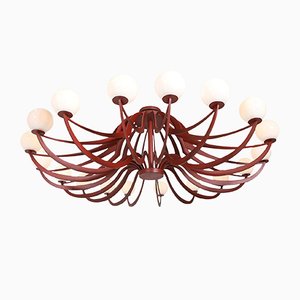
Amsterdam School Chandelier in Ebony, Carved Wood & Glass in Lead and Silk, 1920s
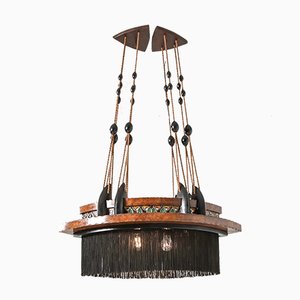
Brass Reed Floor Lamp, 1930s

Brass and Cast Glass Round Dining Table by Ettore Gino Poli for Poliarte, 1970s

Cognac Leather Dining Chairs, 1960s, Set of 4

Cognac Leather Monk Dining Chairs by Tobia & Afra Scarpa for Molteni, 1974, Set of 6

Italian Oak Sideboard with Glass Doors & Space for Bottles, 1970s

Brutalist Five-Door Mahogany Credenza, 1970s
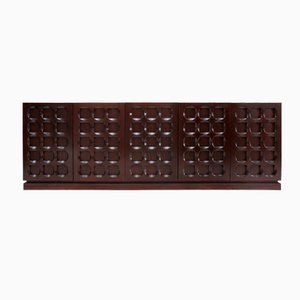
R14 5-Drawer Sideboard by Pierre Chapo, 1960s

Credenza by Vivai Del Sud, 1970s
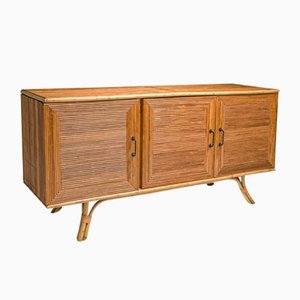
Dining Chairs by Marzio Cecchi, 1970s, Set of 6

Dining Table by Marzio Cecchi, 1990s
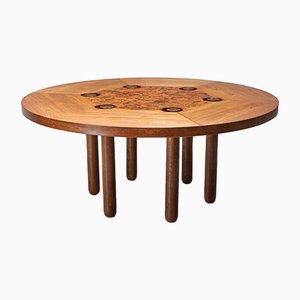
Cognac Leather Dining Chairs by Tobia & Afra Scarpa, 1970s, Set of 4

Brutalist Oak Credenza from De Coene, 1970s

Vintage Model Alada Dining Table by Oscar Tusquets Blanca, 1980s

Marble and Brass Dining Table by Jean Charles, 1970s
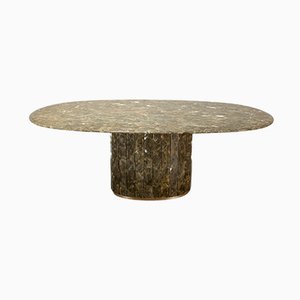
Brass and Opaline Glass Chandelier by Hans-Agne Jakobsson for Hans-Agne Jakobsson AB Markaryd, 1960s

Brutalist Oak & Leather Dining Chairs, 1970s, Set of 6

Leather Lalanda Dining Chairs by Gianfranco Frattini, 1980s, Set of 10

Bamboo, Brass, and Blue Velvet Dining Chair, 1970s
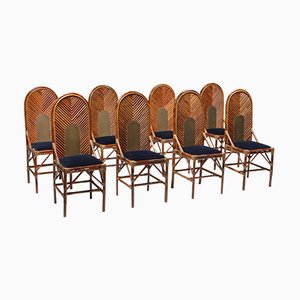
Hollywood Regency Copper Palm Tree Table Lamp, 1970s

Concrete and Glass Dining Table by Saporiti, 1970s

